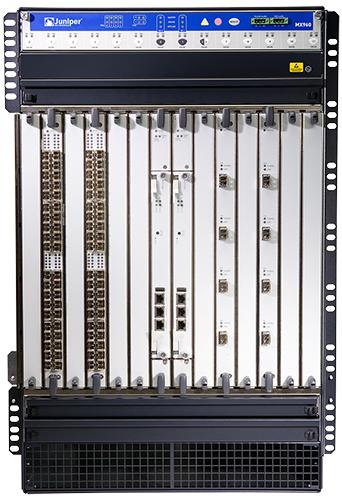JUNIPER MX960BASE-AC vs. MX960-PREMIUM-AC
A lot of our customers ask about what key differences there are in the Juniper MX Series routers, when evaluating the MX960BASE and PREMIUM models. For starters, settle on a specific model with part numbers to illustrate; in this case we’ll use the MX960 which is Juniper’s most dense with a total of 12-slots capable of 5.12 TBps across the back-plane, however this relates to both the MX240 and MX480 as well.
Routing engines: For starters, let’s look at the brains of the operation, which in the Juniper world is called the RE or routing engine. All BASE units come with a single RE-S-1300-2048. This engine uses a single 1.3-GHz Pentium processor and 2048MB of memory (RAM). The PREMIUM models take advantage of redundant RE-S-2000-4096 engines which boasts a 2.0-GHz Pentium processor and double the RAM at 4096 MB.
What does this affect? Well since the processor is used to process L3 traffic the greater the CPU speed the greater the ability to process incoming loads. This translates to overall improved network convergence time as it relates to calculating routes, applying security policies, and traffic monitoring. The RAM on an RE stores the routing information (RIB), which can store multiple instances of full BGP tables. Since memory consumption is a function of the number of distinct paths, the RAM of a given routing engine determines how many distinct paths can be stored which can be critical for Carrier Class Ethernet providers.
Redundancy: In addition, models like the MX960-PREMIUM-AC units feature full hardware redundancy in chassis, including the routing engine, control plane and power supplies. This enables n+ 2 redundancies for PEMs (power ejector modules) as well as an active-passive SCB (switch control board) in addition to the routing engine. Deploying a fully-redundant chassis will circumvent 99% of most downtime issues based on any single hardware component failing, outside the catastrophic yet extremely rare backplane failure. For 100% redundancy networks deploy dual-routers with a fully redundant mesh, in which no single-link, component or even chassis can bring down your network.
Lastly, there is also the issue of PREMIUM2 bundles, which take advantage of Juniper’s 64-bit dual and quad-core routing engines (RE-S-1800x2, RE-S-1800x4), with support for up to 16G RAM as well as enhanced switch control boards (SCBE) and high-watt PEMs (4100W). These are fairly new in Juniper product portfolio and geared towards ultra-high performance routing environments with high-CPU loads on the single-core engines.

